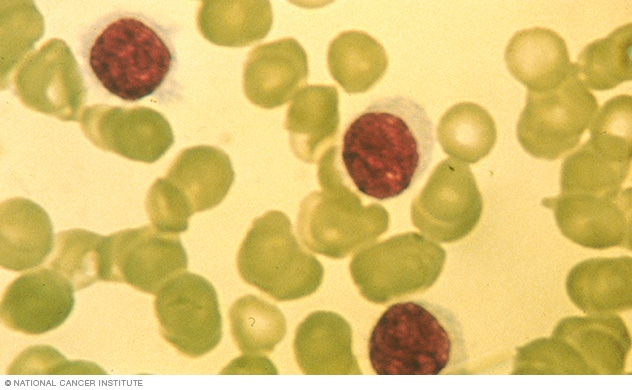Overview
Hairy cell leukemia

Hairy cell leukemia
The darker cells in this photo are hairy cell leukemia cells. Hairy cell leukemia cells look hairy when viewed under a microscope. The "hair" is actually thin projections that stick out from the cell.
Hairy cell leukemia is a cancer of the white blood cells. The white blood cells help fight off germs. There are a few different types of white blood cells. The white blood cells involved in hairy cell leukemia are called B cells. B cells are also called B lymphocytes.
In hairy cell leukemia, the body makes too many B cells. The cells don't look like healthy B cells. Instead, they've undergone changes to become leukemia cells. The leukemia cells look "hairy" under a microscope.
Hairy cell leukemia cells keep living when healthy cells would die as part of the natural cell life cycle. The leukemia cells build up in the body and cause symptoms.
Hairy cell leukemia often gets worse slowly. Treatment might not need to start right away. When it's needed, treatment is usually with chemotherapy.
Scientists found a type of cancer that looks like hairy cell leukemia, but it gets worse much faster. This other type of cancer is called hairy cell leukemia variant. It's considered a separate type of cancer from hairy cell leukemia, even though it has a similar name.
Dr. Rafael Fonseca, hematologist and Chief Innovation Officer at Mayo
Clinic
Call your preferred Mayo Clinic location:
Products & Services
Symptoms
Hairy cell leukemia might not cause symptoms. Sometimes a health care provider finds it by accident during a blood test for another condition.
When it causes symptoms, hairy cell leukemia might cause:
- A feeling of fullness in your belly that may make it uncomfortable to eat more than a little at a time
- Fatigue
- Easy bruising
- Recurring infections
- Weakness
- Losing weight without trying
When to see a doctor
Make an appointment with your health care provider if you have any persistent signs and symptoms that worry you.
Causes
It's not clear what causes hairy cell leukemia.
Hairy cell leukemia begins in the white blood cells. The white blood cells help fight germs in the body. There are a few types of white blood cells. The white blood cells involved in hairy cell leukemia are called B cells.
Hairy cell leukemia happens when B cells develop changes in their DNA. A cell's DNA contains the instructions that tell a cell what to do. The changes tell the B cells to make a lot more B cells that don't work right. These cells go on living when healthy cells would die as part of the natural cell life cycle.
The B cells that don't work right crowd out healthy blood cells in the bone marrow and other organs. This leads to the symptoms and complications of hairy cell leukemia. For example, the extra cells can cause swelling in the spleen, liver and lymph nodes. If there isn't enough room for healthy blood cells, this can lead to frequent infections, easy bruising and feeling very tired.
Risk factors
The risk of hairy cell leukemia may be higher in:
- Older adults. Hairy cell leukemia can happen at any age. But most people diagnosed with hairy cell leukemia are in their 50s or 60s. It's rare in children.
- Males. Hairy cell leukemia can happen to anyone. But it's more likely in males.
Complications
Hairy cell leukemia often gets worse very slowly. Sometimes it stays stable for many years. For this reason, few complications of the disease occur.
Too few healthy blood cells
If there are too many leukemia cells in the body, they can crowd out the healthy blood cells. That can lead to:
- Infections. Your body needs healthy white blood cells to fight off germs. If your body can't make enough healthy white blood cells, you might get more infections.
- Bleeding. Your body needs healthy platelet cells to control bleeding. If the number of platelets in your blood is low, you might notice that you bruise more easily. You might also have bleeding from the nose or gums.
- Anemia. Your body needs healthy red blood cells to carry oxygen through your body. Having too few red blood cells is called anemia. Anemia can make you feel very tired.
Increased risk of other cancers
Some studies found that people with hairy cell leukemia have an increased risk of other types of cancer. The other cancers include non-Hodgkin's lymphoma, Hodgkin's lymphoma and others. It's not clear if the other cancers are caused by hairy cell leukemia or by cancer treatments.